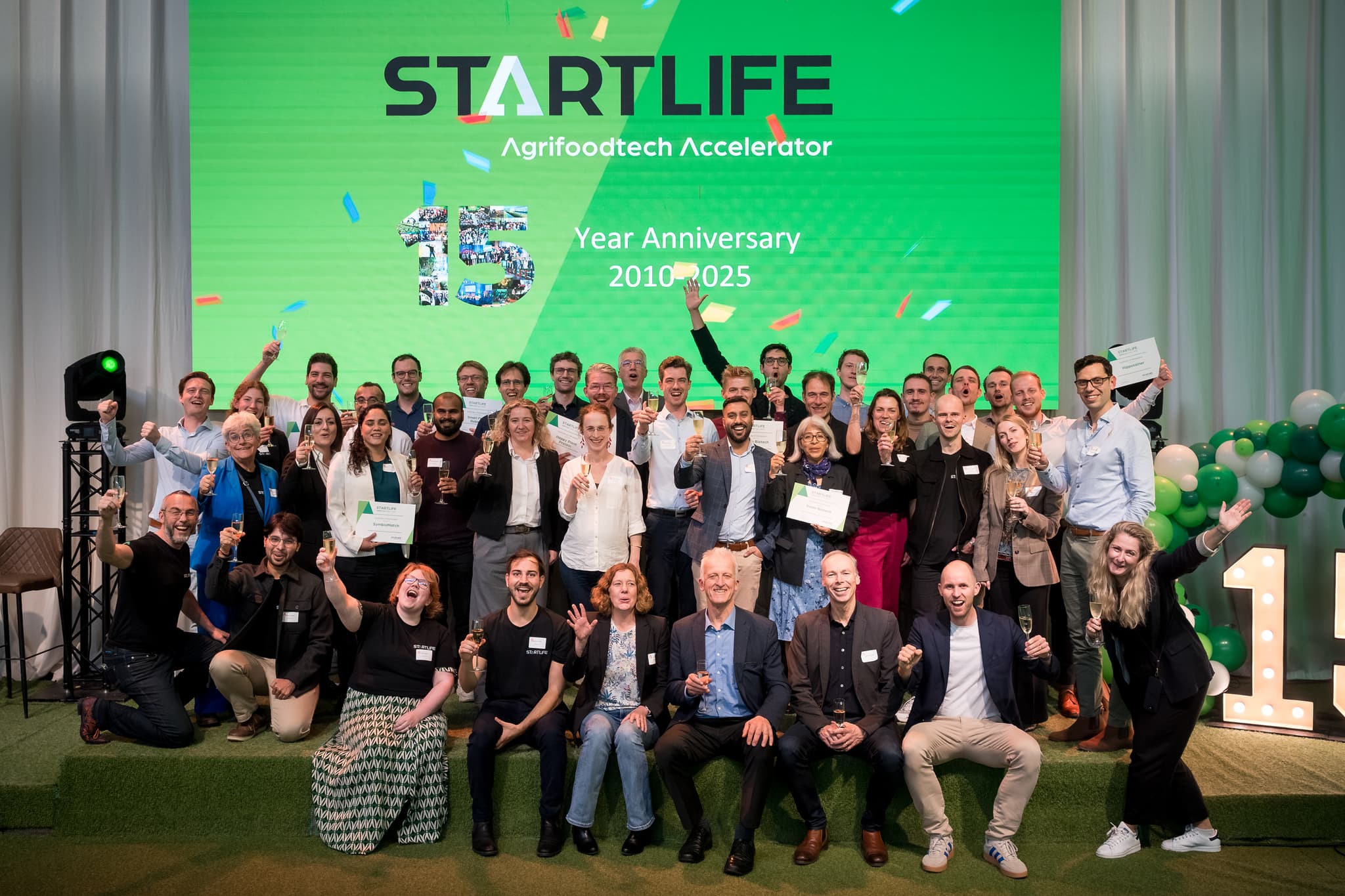TerraChange Solar harvests the sunlight twice: energy and food
Transparent solar panels that let plants grow and electricity flow, reshaping the balance between food and energy.
Published on November 5, 2025
TerraChange Solar © Startlife
Bart, co-founder of Media52 and Professor of Journalism oversees IO+, events, and Laio. A journalist at heart, he keeps writing as many stories as possible.
At StartLife’s 15th anniversary celebration in Ede, eleven pioneering agrifoodtech startups took the stage to show how science and entrepreneurship can reshape the future of food. From smarter biostimulants and energy-efficient farming robots to next-generation proteins and nutrient innovations, each team presented a bold solution to one of the world’s most urgent challenges: feeding a growing population within planetary limits. In this IO+ series, we highlight their stories; not just the technologies they’re building, but also their vision and the advice they received from the expert panels. Today, we focus on TerraChange Solar.
Moritz Riede, CEO of TerraChange Solar, took the stage at StartLife’s Demo Day in Ede with a simple truth every grower knows too well: “Energy prices have surged over the past few years, and they keep rising.”
For greenhouse farmers, that sentence is more than a headline. It’s an existential problem. “We’ve heard firsthand from growers about the pressure this puts on them,” Riede said. “The time of cheap gas is over. High electricity costs are blocking electrification; taxes and grid charges often make up 50% of the bill. And that, in turn, raises food prices.”
His solution is elegant, scientific, and surprisingly beautiful: transparent solar panels that generate power while letting plants thrive beneath them.
Harvesting light twice
“Our panels selectively absorb only the light that plants don’t need,” Riede explained. “They use that part of the spectrum to generate electricity, and let the rest pass through for photosynthesis.”
That means greenhouses can become self-powering farms: producing both food and energy from the same sunlight. “With our technology,” he said, “growers can cut their energy costs by 30%. The panels integrate seamlessly into greenhouse roofs, require no extra maintenance, and actually support better crop growth.”
Riede’s team has already moved beyond theory. “We’ve built large-area prototypes and completed lab testing,” he said. “Now we’re running plant trials with leafy greens and flowers; crops that help growers see how the technology works in practice.”
The early results are promising. “Trials with similar filtered light have shown that certain plants grow even better,” he noted. “It’s not just about saving money. It’s about improving quality.”
From Oxford to the greenhouse roof
TerraChange Solar’s story began in the labs of the University of Oxford, where Riede spent a decade researching next-generation solar materials. “I founded TerraChange to bring a different, better kind of solar technology to the market,” he said.
He has since teamed up with Pascal Kaienburg, a fellow solar scientist from Oxford, and Chris Charles, a serial entrepreneur who has grown three startups to more than fifty employees. Together, they’re turning a research breakthrough into a business poised to transform agriculture and energy at once.
“We’re kicking off our fundraising now,” Riede announced. “And we’re looking for partners who believe that greenhouses can power themselves — sustainably, efficiently, and beautifully.”
Food, energy, and speed
The Q&A that followed revealed the strategic balancing act the startup faces. Riede’s “beachhead market” is clear: glass greenhouses, a global market led by crops such as tomatoes, cucumbers, and peppers. “Tomatoes are our main target,” he said. “They account for about half of all greenhouse crops worldwide.”
But tomatoes also come with a challenge. “They have long growth cycles, nearly a year,” he explained. “That makes it hard to iterate and test quickly.”
Should the company focus on faster-growing crops, like cucumbers, to move faster, or stay laser-focused on the lucrative tomato market, where the potential is largest?
Speed meets proof
The panelists encouraged a pragmatic approach. “You’re looking for early signs of traction,” one investor said. “If you can show that your technology works with cucumbers, that it translates easily to tomatoes, and that growers are willing to pay, that’s valuable proof.”
Another panelist agreed. “Speed matters. Investors want to see data, even if it’s from a smaller market. You can always move to tomatoes once you’ve proven performance and interest elsewhere.”
A third voice offered a strategic layer: “If your intellectual property is strong, if your patents are secure, you can afford to go slower and focus on tomatoes. But if you’re still building that protection, then speed becomes your best defense.”
Riede nodded. “We’ve already filed key patents,” he said. “And we have a clear roadmap for more. But either way, we want to move fast, because growers need solutions now. Our panels directly address a major pain point: energy costs. They make greenhouses more self-sufficient and resilient.”
A future of dual harvests
TerraChange Solar’s technology fits perfectly within a broader shift: the dual-use of land and infrastructure for both food and energy production. In an era of rising demand and tightening resources, that approach could become a cornerstone of sustainable agriculture.
“Our panels make it possible to harvest sunlight twice,” Riede summarized. “Once as food, once as electricity. It’s the most natural form of efficiency there is.”
For farmers battling both climate volatility and energy inflation, that combination could be transformative, turning every greenhouse roof into a micro power plant.

15 years Startlife
Read about all the startups that were part of StartLife’s 15th anniversary Demo Day.
